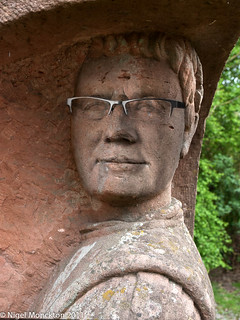What, then, is special about photography?
There is one clear difference between photography and painting. A photograph is always a photograph of something which actually exists. Even when photographs portray such nonentities as werewolves and Martians, they are nonetheless photographs of actual things: actors, stage sets, costumes. Paintings needn't picture actual things. A painting of Aphrodite, executed without the use of a model, depicts nothing real.
Walton, Transparent Pictures
 |  |
| Portrait of a Young Woman with a Unicorn: Raphael [Public domain], via Wikimedia Commons | Portrait of the photographer as a roman statue |
I’m struggling with this bit of the exercise. We are asked to give a 200 word reflective response to an extract from Transparent Pictures: On the Nature of Realism – by Kendall Walton and I can’t help thinking it’s errant nonsense from beginning to end. Clearly that’s not a terribly rational response, so this is an attempt to help me get my head around just one bit of it – the quote above.
One of the above images is clearly a painting – the other clearly a photograph (digitally altered – but most people would regard it as a photo I think). My problem is that I would maintain that they demonstrate exactly the opposite of Walton’s assertion. I have never been a Roman statue – so it’s a photo of something that doesn’t exist. But..the statue exists, and I exist – so really it’s just two photos of some things that exist displayed simultaneously to create an effect I saw in my imagination by using items stored in my memory.But what if we apply the logic to the painting. The lady apparently existed. Pillars exist – Raphael didn’t invent them – he’d seen pillars before and he’s reproduced them here – either from memory or by looking at some similar pillars. Aha..the unicorn! What is a unicorn – it’s a horse with a horn on its head. Horses exist.. etc. Horns exist..etc. So really this is a painting of some things that exist displayed simultaneously to create an effect Raphael saw in his imagination by using items stored in his memory.
Would the argument still hold if I had only used a single image – of myself or the statue? I think it would, as by selecting the timing and composition, depth of field and processing – a subset of the various realities available to me - I produced an image that I saw first in my imagination using information (items) stored in my memory.
For Walton’s assertion to hold true the painting of Aphrodite would have to be executed by an artist who had never seen a woman, so that the end result would be completely imaginary – having no link to any previous experience of the artist. I think Escher would be more of a challenge to my suggestion, but even there the individual bits exist – at least in prototype, somewhere - and have simply been assembled in a manner which distorts single point perspective.
I may be missing something here but I’m not sure – certainly not in the digital medium it has become – that the claim that the key difference between painting and photography is the existence of the subject really holds water.
No comments:
Post a Comment